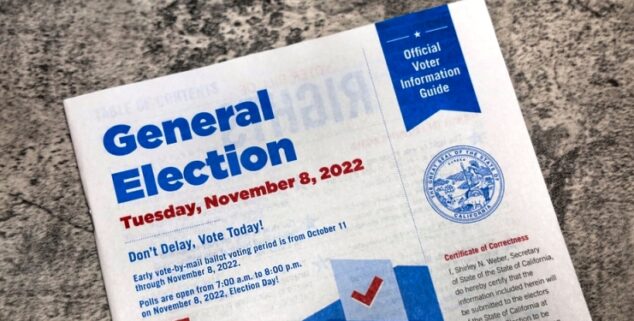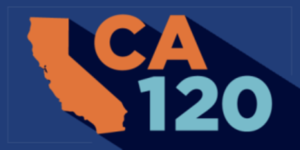News
CA120: Will vote-by-mail conspiracies rain on Republicans’ parade?
 2210901167
2210901167Heading into Election Day we have seen shifts nationally that appear to advantage Republicans, putting the GOP on track to regain control of Congress and pushing a number of competitive races in California into “toss-up” territory.
But with Republicans knocking on the door of potential gains, even despite a redistricting that appeared to reinforce Democratic districts and weaken Republican-held seats, could their own messaging on vote by mail get in the way?
There is rain forecast for Irvine, Santa Clarita, Stockton, and Merced. All areas with some of the most competitive congressional races in the country.
As long-time followers of the Political Data Vote Tracker know, Republicans used to have significant advantages in the early vote, with the initial returns on election night providing strong performances for GOP candidates, with Democrats having to play catch-up with in-person and last-minute mail-in ballots.
But the 2020 election introduced conspiracy theories by then-President Donald Trump, amplified on conservative news networks and spread on social media. Republicans, who had previously enjoyed built-in structural advances using vote-by-mail, were suddenly against it. And, reflexively, Democrats embraced the process even more.
In one Capitol Weekly survey in June of 2020, we asked voters if they supported a by-mail system for that election and 98% of Democrats supported it, compared to just 30% of Republicans.
It is now two years after many of these conspiracies began, but they seem still persist with a large segment of Republican voters — although there is no proof that there is any problem at all with early voting.
As part of ongoing polling, we surveyed California voters on how and when they planned on voting, and if they felt that their vote would count if they cast it by mail. The results are surprisingly close to what we saw in 2020.
A significant share of Republican voters plan on voting in-person at a local vote center or polling location — 44% of Republicans say they will vote at a polling place and 36% say they won’t vote until Election Day. This is compared to just 6% of Democratic voters who plan on voting in-person and 9% who say they will vote on Election Day.
| How do you plan on returning your ballot? (N=1473) | ||||||
| Democrat | Republican | NPP / Other | ||||
| 359 | 49% | 147 | 35% | 159 | 50% | |
| Drop Box | 327 | 45% | 89 | 21% | 114 | 36% |
| Polling Place | 42 | 6% | 187 | 44% | 47 | 15% |
| When do you plan on returning your ballot? | ||||||
| Democrat | Republican | Other | ||||
| As soon as I receive it | 166 | 23% | 56 | 13% | 50 | 15% |
| Within a couple of weeks of receiving it | 378 | 52% | 151 | 36% | 141 | 44% |
| A couple of days before Election Day | 114 | 16% | 62 | 15% | 81 | 25% |
| On Election Day | 63 | 9% | 153 | 36% | 49 | 15% |
The reasons for these decisions on how and when to vote clearly come from the 2020 voter fraud conspiracies. Among Republican voters, 54% are not confident that their ballot will be received and counted if they return it by mail. This is in contrast to just 3% of Democrats.
| How confident are you that your ballot will be received and counted if you return your ballot by mail? | ||||||
| Democrat | Republican | NPP/Other | ||||
| Extremely Confident | 577 | 79% | 72 | 17% | 203 | 64% |
| Somewhat confident | 130 | 18% | 121 | 29% | 59 | 18% |
| Not very confident | 17 | 2% | 79 | 19% | 29 | 9% |
| Not at all confident | 4 | 1% | 116 | 27% | 27 | 9% |
| Believe it will not be received/counted | 1 | 0% | 36 | 9% | 1 | 0% |
| Total Confident | 707 | 97% | 193 | 46% | 262 | 82% |
| Total Not Confident | 22 | 3% | 230 | 54% | 58 | 18% |
We have already seen some of the impacts of these choices in the early voting. Looking at data from this week and the opening of the 11-day vote centers, we see a shift toward a more Republican electorate.
Among the by-mail and drop box returns, we see Democrats slightly out-performing their rate of registration at 51% of returns, compared to their 47% of registered voters. Republicans are at 28% of ballots, compared to their 24% of registration.
Republicans may have a big nearly 30-point swing, but it is only among 3% of the electorate that has voted in person so far.
However, with the relatively small number of ballots cast at in-person centers, Republicans are dominating with 43% of ballots compared to 38% of Democrats. This is a massive 28-point flip toward Republican voters – and it is likely many of these in-person Independents are more conservative than the by-mail independent voters.
The saving grace for Democrats is that this is only currently accounting for a small portion of total votes. Republicans may have a big nearly 30-point swing, but it is only among 3% of the electorate that has voted in person so far. The big in-person day will be Tuesday, on Election Day itself.
We saw the impact of the Election Day Republican lean in the results of the 2022 primary. As a result of how votes are tabulated and reported, close observers can effectively discern which votes are coming from early vote-by-mail, and which are coming from Election Day in-person voters.
The California Target Book was capturing this data as it came in, and thanks to data collection by Rob Pyers we can see a rather amazing story of different tranches of voters in the competitive Southern California congressional districts varied by partisanship.
The Election Day in-person vote is smaller as a percentage of the total votes cast, with it comprising just around 15% of votes in the primary election.
The following table takes all votes for Democratic and Republican candidates, sums them up, then breaks them out by when in the reporting they were posted: Either Early Vote, comprised of those ballots that are already at the County Registrar’s office before polls open, then Election Day, which is comprised by in-person votes that don’t come in by-mail envelopes and don’t need to be signature verified, and finally the Late Counted ballots that are those which come in the mail and at drop boxes on Election Day, or after provided they have a postmark by Election Day.
The results of this analysis are striking.
2022 Primary Vote by Tranches and Partisanship
| Early Vote | Election Day | Late Counted | Final | |
| CD27 | D +7% | R +50% | D +7% | R +1% |
| CD40 | R +5% | R +66% | R +16% | R +18% |
| CD45 | R +7% | R +57% | R +9% | R +14% |
| CD47 | D +16% | R +51% | D +5% | D +3% |
| CD49 | D +15% | R +56% | EVEN | D +3% |
Overall in these competitive districts, early mail and drop-box ballots were advantaging Democratic candidates by 5.2%, but then the Election Day Vote was a wild swing to a Republican advantage of 56%.
Yes, you read that right – the total shift from early vote, comprising more vote by mail, to Election Day vote comprising more in-person voters, was a whopping 61% swing.
The Election Day in-person vote is smaller as a percentage of the total votes cast, with it comprising just around 15% of votes in the primary election. So, a 60% swing among this population is not going to decide every race, but it is a significant portion. In fact, in these races, the in-person Election Day vote comprised nearly 20% of the votes for Republican candidates and just 5-6% for Democrats.
Republicans are counting on these big single-day partisan swings in each of these competitive elections.
The real question in close contests is how heavily polarized Republican these Election Day voters are, and how many of them show up at the polls. And that’s where we may find some challenges for California Republicans headed into these final hours of the mid-term elections.
Relying on in-person voting makes your voters subject to whatever potential distraction or hurdle that can befall a voter on Election Day. A sick kid, a boss that makes you stay late at work, an accident or just realizing that you have to go get groceries for dinner – any of those normal life events can, if they land on Election Day, end up deterring someone who intends to vote from actually voting.
A by-mail voter, facing one of these life events in mid-October, can just mail their ballot the next day. But there is no “next day” for a voter who decides to only vote on Election Day.
It sounds trivial, but consider the weather forecasts for Tuesday. There is rain forecast for Irvine, Santa Clarita, Stockton, and Merced. All areas with some of the most competitive congressional races in the country. If Republicans choosing to vote on Election Day look out the window and see rain, or if they get stuck in bad traffic, or they have their kid’s baseball practice get rained out – any of those things could mean that they don’t end up voting.
Republicans, having self-segregated themselves to voting in-person and on Election Day, are counting on these big single-day partisan swings in each of these competitive elections. And if they don’t show up to vote on Tuesday, one of these races could be decided by something as seemingly trivial as the rain.
—
Editor’s Note: Paul Mitchell, a regular contributor to Capitol Weekly, is the creator of the CA120 column, vice president of Political Data and owner of Redistricting Partners, a political strategy firm.
Want to see more stories like this? Sign up for The Roundup, the free daily newsletter about California politics from the editors of Capitol Weekly. Stay up to date on the news you need to know.
Sign up below, then look for a confirmation email in your inbox.

Leave a Reply